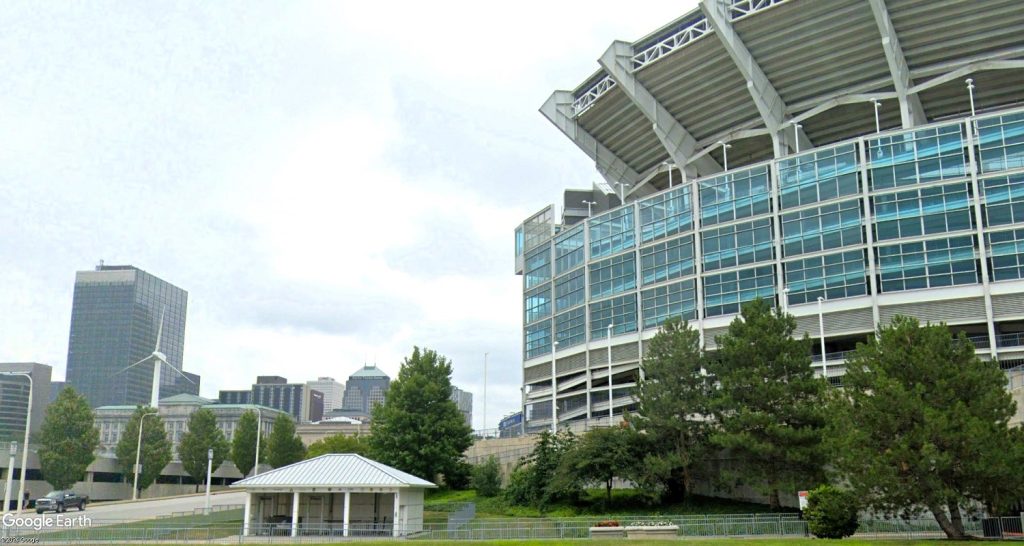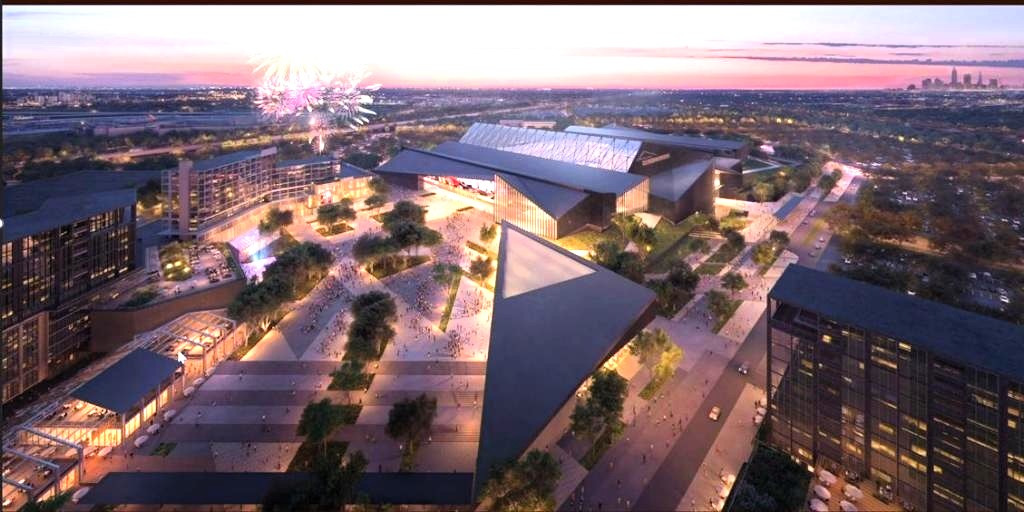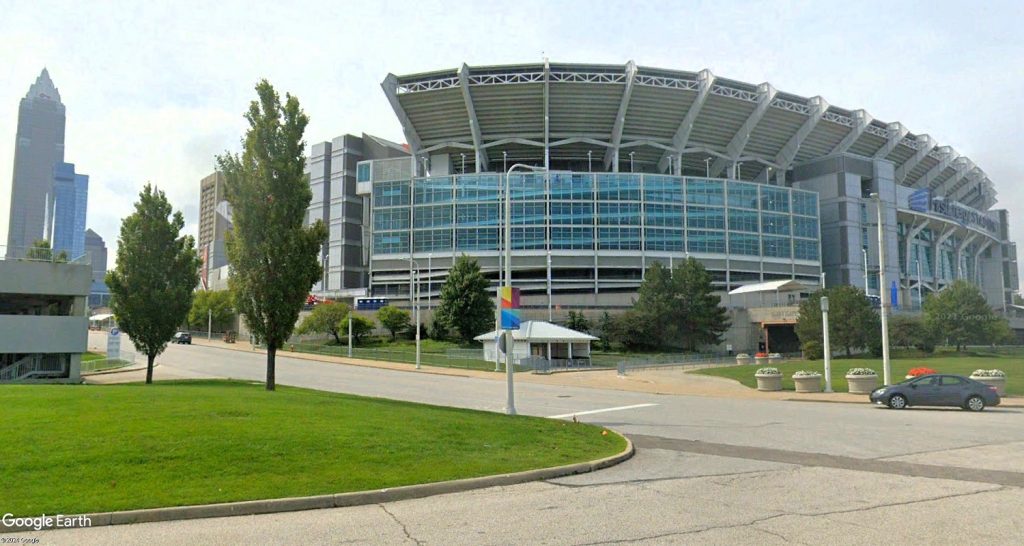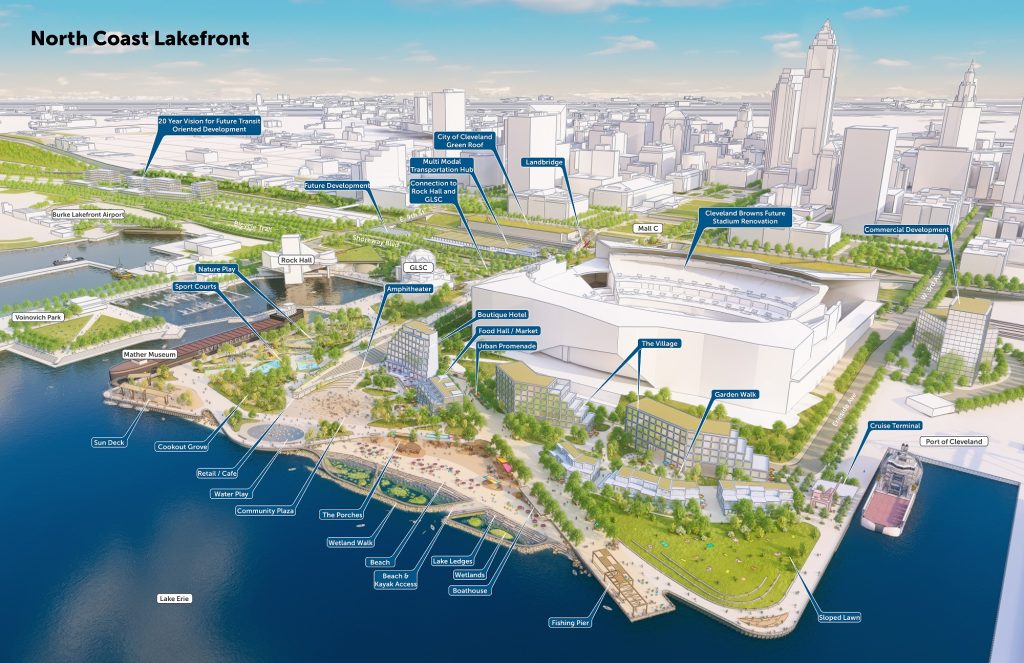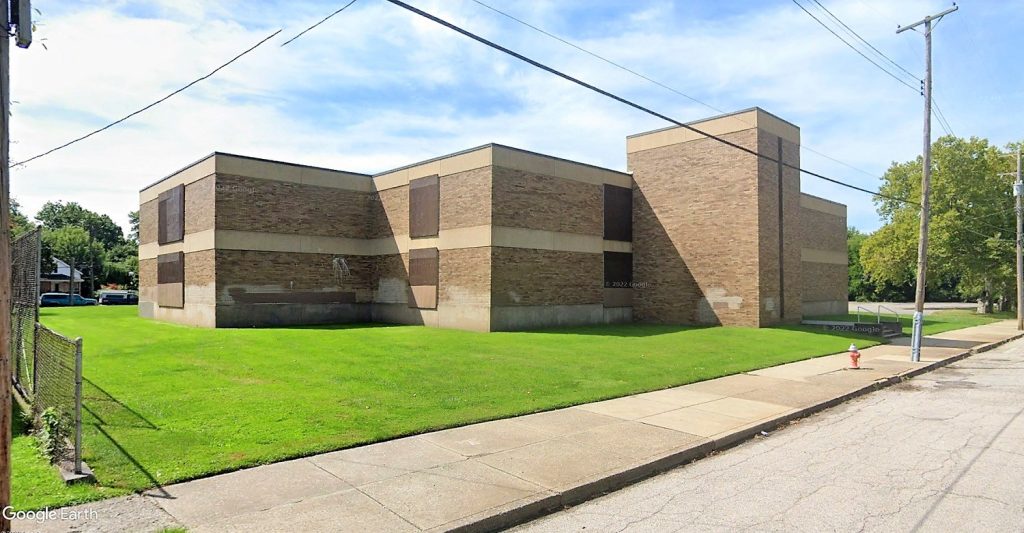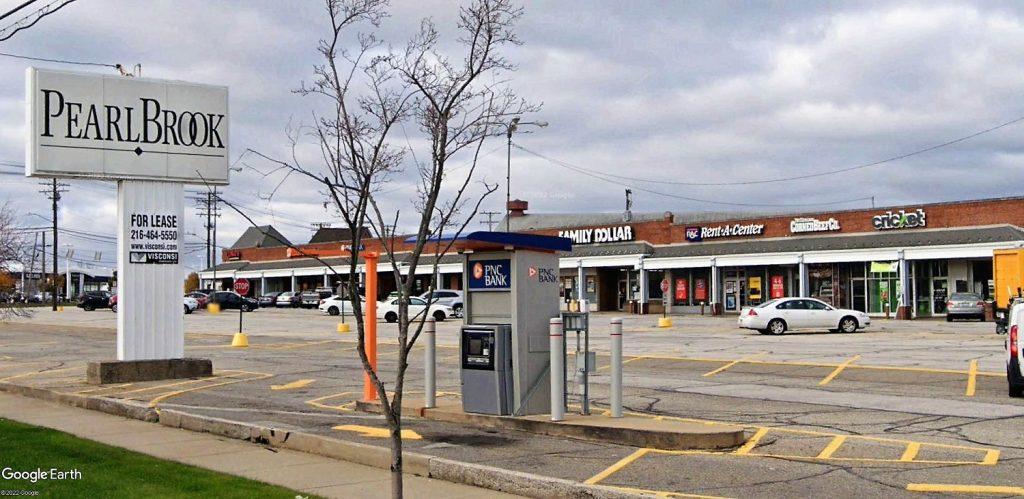Sources: Browns likely going to Brook Park

Cleveland Mayor Justin Bibb sent a letter today to Jimmy and Dee Haslam, owners of the Cleveland Browns, urging them to stay in Downtown Cleveland. Bibb also publicized the city’s $461 million contribution to renovate Cleveland Browns Stadium to show to the public that the city has made a strong financial offer to the National Football League team. But that might not be enough to keep the Browns at the deteriorating lakefront stadium.
Sources have informed NEOtrans that the Haslams prefer to relocate the team to a proposed domed stadium in suburban Brook Park after their 30-year lease downtown expires after the 2028 season. The Haslams have a purchase agreement to acquire 176 acres of land at 18300 Snow Rd., site of two former Ford auto plants. NEOtrans broke the story in February about the purchase agreement and was first to publish a rendering of the proposed domed stadium.
While it may not be a done deal yet, the timing of Bibb publicizing the letter and his administration’s offer to the team strongly suggests that Bibb recognizes the Haslams are at least favoring the suburban site. The sources who spoke to NEOtrans on the condition of anonymity emphasized that the letter wouldn’t have been sent and the offer publicized if Bibb and his staff were comfortable with the Haslams’ responses to them. Bibb asked the Haslams to respond to his offer by Aug. 12.
“Losing the Browns would harm Cleveland and all Clevelanders,” Bibb said in written press statement. “Lower spending downtown would negatively affect tax revenues that provide essential services for a city in need. It would close businesses, cost jobs, empty out storefronts, and make our downtown feel less alive.”
He also took a shot at Haslams’ proposed $2.4 billion domed stadium in Brook Park that could feature about $1.4 billion in supportive development around. At current construction prices, such supportive development would equate to a small downtown of 3.5 million to 5.6 million square feet of new apartments, hotels, restaurants and entertainment.
“We are unified in our belief that transforming the current facility is unquestionably in the best interests of Cleveland and Cuyahoga County,” Bibb said in his letter to the Haslams. “We do not believe any public financial support should responsibly be made available for development of a stadium outside of the city of Cleveland.”
He also said a newly built venue would cost taxpayers, including Clevelanders, hundreds of millions more while undermining the city and region’s other critical needs. He said “a strong urban core drives success for the entire region.”
Dave Jenkins, chief operating officer at the Haslam Sports Group, said his group “appreciates the latest proposal” from the Bibb administration. He said the Haslam Sports Group will be following up with city officials to “better understand the details of the proposal.” Those remarks suggested surprise at Bibb’s proposed and his public comments. Parties in a negotiation typically do not like to conduct those negotiations in public.
“As we have said consistently throughout this process, we continue to communicate and collaborate with the cities of Cleveland and Brook Park, Cuyahoga County, and the State of Ohio on a long-term stadium solution that creates a world-class experience for our fans and positively impacts Northeast Ohio,” Jenkins said.
“We are working diligently to comprehensively examine all options to identify the best path for not only our fans, but also Greater Cleveland and Northeast Ohio,” he continued. “Our region deserves to be thought of as evolving, forward-thinking, and innovative, so we need to think boldly and creatively in this process.”
He also emphasized that the Haslams’ goal is to offer the best experience possible for fans while creating “a long-term, sustainable stadium solution.”
That last part is an important point as Cleveland City Council weighs the latest request from the team to make $3.7 million in emergency repairs to the stadium. Proposed are rebuilt pedestrian ramps, replaced gutters and a new hot water tank. City Council members are balking at making the repairs if the team decides to leave anyway for Brook Park.
Two years ago, the city made $10 million in emergency repairs to replace other crumbling, rusted pedestrian ramps, plus deteriorated concrete elsewhere in the stadium, new lighting, heating and doors. NEOtrans has learned that the 1999-built stadium was quickly and poorly built and is deteriorating rapidly. The city is responsible for emergency repairs per its lease with the Browns.
Cuyahoga County Executive Chris Ronayne told NEOtrans that any decision involving public-private investments in a new or rebuilt stadium for the Browns must be made in a larger context.
“The Browns are part of a broader discussion involving all three major (Cleveland) sports teams — the Guardians, Cavs and the Browns,” Ronayne said. “And our goal is to effectuate a strong public-private partnership that’s fair to the citizens of Cuyahoga County and fosters a long-term relationship of all three teams. Our focus now and into the future will be in assuring that long-term relationship. We have to think about the recreational needs, especially our youth in Cuyahoga County. We look forward to leading the conversation with all three teams.”
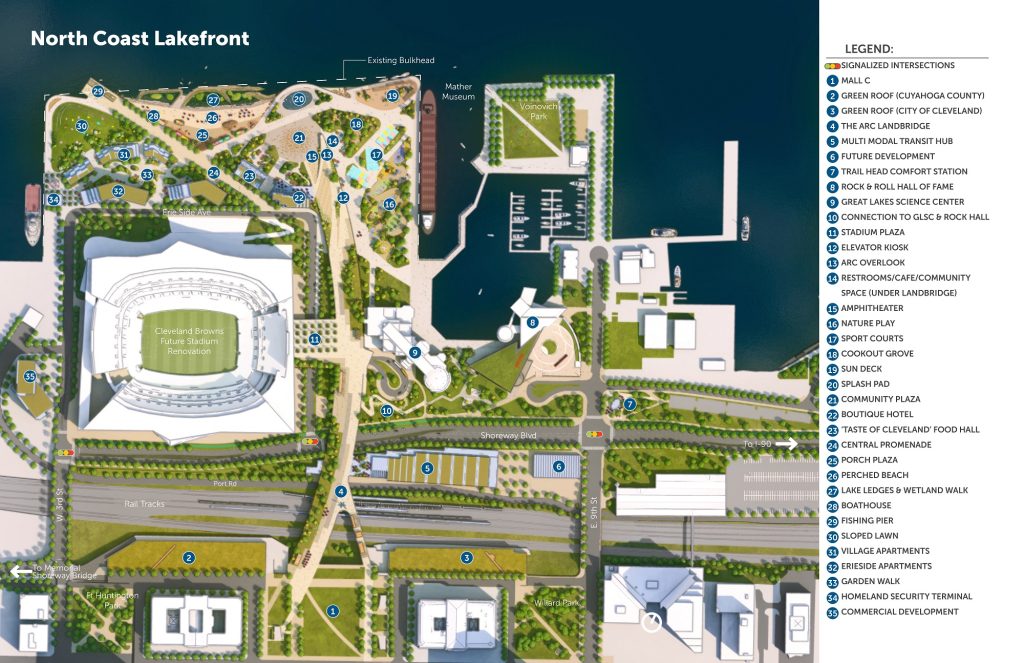
Cleveland Mayor Justin Bibb wants Cleveland Browns Stadium to be a part of the lakefront redevelopment, as proposed here (FO).
Bibb said the stadium is more than just a venue and that keeping the Browns in Cleveland is vital for sustaining downtown’s successes, regional health and the city’s global image.
“We are implementing a bold vision for lakefront development, and the Browns have been an essential fixture on our lakefront for decades,” Bibb said. “But our first priority is always our residents. Having the Browns play here is integral to our city’s identity and community spirit. This initiative must go beyond the Browns and be about what’s best for downtown, the neighborhoods, the suburbs, and the region.”
He pointed to the $7.5 billion that was invested into Downtown Cleveland in the last decade. There is an opportunity to build on the many public investments that have already been made including Progressive Field, Rocket Mortgage Fieldhouse, the Hilton Hotel and the Huntington Convention Center, and private investments including the new Sherwin-Williams headquarters, the Rock and Roll Hall of Fame expansion, and the Flats East Bank.
The Bibb administration said its proposed 30-year lease arrangement balances the needs of residents and the team. He said it is designed to provide the Browns with a dramatically transformed facility that will serve the region for decades and provide the Browns and their fans with the positive experience they want as part of the city’s lakefront transformation.
The funding model ensures that fans paying for tickets cover the cost of upgrades without negatively impacting the city budget. Cleveland is committed to using revenues that would not exist but for this project. This approach assures equity, given that 70 percent of the stadium’s users come from outside of Cuyahoga County. The total city investment would be $461 million without any impact to city services, and that is before any pending county and state commitments.
Terms of the city’s proposed financial contribution to a renovated Cleveland Browns Stadium include:
- $367 million ($227 million from increases in admission tax revenues, $120 million from Cuyahoga County sin tax revenues, and $20 million in existing stadium capital reserves) over the 30-year lease term, with a five-year renewal option.
- The city will turn the Willard Garage and the Municipal Parking Lot over to the Browns for their exclusive use on game days and event days. Parking revenues are expected to generate $94 million for capital repairs and improvements.
- Under the current lease, the city covers $1.3 million in annual property taxes and insurance, while the Browns pay $250,000 in rent. Under the proposed new lease, rent will be waived for the Browns, but they will assume responsibility for the insurance and tax payments. This adjustment aligns with the lease agreements held by the Guardians and Cavs, making it consistent across sports franchises in Cleveland.
The proposal benefits Cleveland and Cuyahoga County residents by enhancing the facility and saving the public hundreds of millions in new construction costs. It is a strategic investment that sets the stage for Cleveland Browns Stadium to continue to serve as an economic engine for Greater Cleveland, Bibb said.
END

